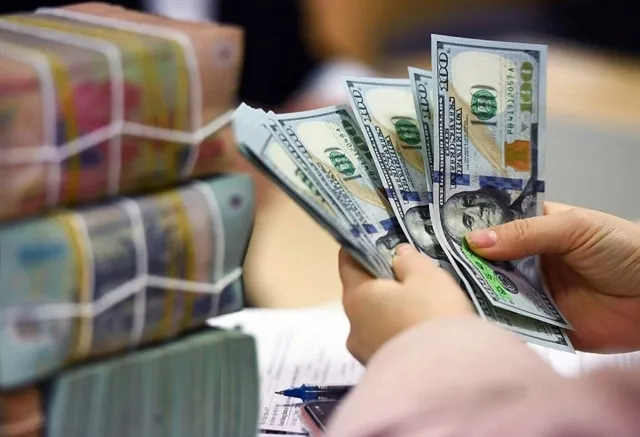
Meanwhile, importers and those reliant on raw material purchases for production are deeply concerned about the escalating USD.
Happy, Yet Worried
Discussing the recent surge in exchange rates, Mr. Nguyễn Ngọc Luận, General Director of Global Trading Co., Ltd. (owner of the Meetmore agricultural coffee brand), acknowledges the positive impact on exporters, including Meetmore. However, he emphasizes that the substantial increase in input costs offsets much of the benefit. The price of raw coffee has risen by 3.4 times compared to last year, putting exporters at a disadvantage, especially with existing contracts signed at lower prices.
"Existing contracts must be honored, and negotiating new ones poses a significant challenge. While we aim to gradually raise selling prices by 5-10% to accommodate customers, a true reflection of our increased costs would require a 40% price hike. Failing to secure new contracts after fulfilling current orders could force us to suspend operations temporarily," expresses Mr. Luan, voicing his concerns.
Mr. Nguyễn Văn Thứ, Chairman of the Board of Directors of G.C Food JSC (G.C Food), shares insights into the challenges faced in the export of agricultural products. He notes that geopolitical uncertainties and soaring logistics expenses are prompting customers in the Middle East and Europe to scale back imports. In response, G.C Food is compelled to offer discounts to retain its customer base in vital markets like Japan, Korea, and Southeast Asia.
"The depreciation of currencies in key markets, such as the Japanese Yen, adds to the strain on importers, compelling them to negotiate lower prices with exporters like G.C Food to alleviate financial pressures," explains Mr. Thu, outlining the complex dynamics influencing the export landscape.
Textile and garment exporters face unique challenges amid currency fluctuations. Despite the surge in the USD, this industry doesn't reap significant benefits due to the need to import costly materials. Moreover, the prices of exported garments remain unchanged, exacerbating the situation. Additionally, escalating logistics expenses further strain exporters.
"In the garment sector, exporters are typically responsible for FOB delivery to the port. However, with rising logistics costs, importers demand that sellers share this financial burden," explains the predicament faced by textile and garment exporters.
Moreover, stringent green and clean product requirements in demanding markets like Europe add another layer of complexity. Exporters must navigate these dual challenges, making the situation increasingly intricate.
Import Enterprises Under Pressure
Ms. Lý Kim Chi, Chairperson of the Ho Chi Minh City Food and Foodstuff Association, sheds light on the challenges facing import enterprises. As the prices of imported raw materials soar, these enterprises find themselves in a tough spot. While the logical response would be to increase selling prices, weak purchasing power in the market constrains their ability to do so. Consequently, many importers are compelled to participate in various shopping stimulus programs to bolster consumer spending, further squeezing their profit margins.
A flour business representative echoes this sentiment, emphasizing the struggle to maintain prices amid escalating costs of imported raw materials. Should the exchange rate continue its upward trajectory in the coming months, import enterprises might be left with no choice but to raise selling prices to offset their expenses, regardless of prevailing market conditions.
Mr. Trần Đình Long, Chairman of Hoa Phat Group, recently addressed shareholders at the company's 2024 Annual General Meeting of Shareholders, shedding light on the challenges posed by the escalating exchange rate. Hoa Phat Group, a prominent player in the industrial sector, revealed that it has been significantly affected by the currency fluctuations. In response to this volatility, the group anticipates setting aside exchange rate provisions totaling approximately 200 billion dong in the first quarter of the year.
The primary reason behind this financial provision is the group's heavy reliance on imported raw materials, juxtaposed with a predominantly domestic consumer base. Moreover, Hoa Phat Group also maintains a certain proportion of foreign currency loans within its overall loan structure, exacerbating its vulnerability to exchange rate fluctuations. This candid assessment underscores the broader impact of currency dynamics, extending beyond the food and consumer goods sectors to encompass key industrial fields such as steel.
During the conference aimed at deploying monetary policy management tasks in 2024, with a focus on addressing production and business challenges, fostering growth, and stabilizing the macro economy, Mr. Đặng Ngọc Hòa, Chairman of the Board of Vietnam Airlines, emphasized the significant impact of exchange rate fluctuations on the airline industry. He highlighted that even a marginal 1% fluctuation in the exchange rate leads to substantial losses for Vietnam Airlines, amounting to 300 billion dong. This financial burden escalates drastically to 1,500 billion dong with a 5% fluctuation. Consequently, Vietnam Airlines strongly advocates for exchange rate stability at the lowest possible level to mitigate financial risks and ensure operational sustainability.
The latest statistics from the General Statistics Office reveal that export-oriented businesses, despite initial expectations of benefiting from exchange rate fluctuations, are not experiencing significant advantages. During the first four months of 2024, the estimated trade surplus in goods amounted to 8.4 billion USD, compared to an export surplus of 7.66 billion USD during the same period last year. Delving deeper, it is observed that the domestic economic sector faced an import deficit of 8.24 billion USD, while the foreign-invested sector, including crude oil, recorded an export surplus of 16.64 billion USD. This data suggests that in scenarios where the exchange rate increases, the primary beneficiaries tend to be foreign direct investment (FDI) enterprises, whereas domestic enterprises are more vulnerable due to their significant trade deficit.




















